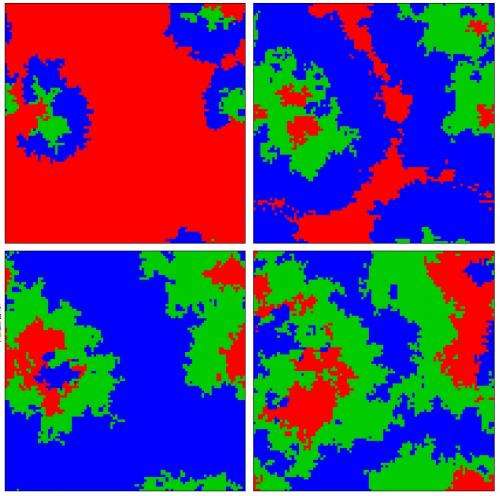November 7, 2014 feature
Deceptive behavior may (deceivingly) promote cooperation

(Phys.org) —Tricking someone into trusting you in order to gain something from them is common behavior in both the animal and human worlds. From cuckoo birds that trick other bird species into raising their young, to cunning salespeople who pretend to sell you a product that will improve your life, deviant behavior takes many forms. But no matter the situation, the result is that a single individual gains something while the community at large loses.
For researchers who study the evolution of cooperation, deceitful behavior seems to throw a wrench in mechanisms that promote cooperative behavior. Questions arise such as, under what conditions does deception evolve? How effective are strategies to identify deceitful behavior? And how can deceitful behavior coexist with cooperative behavior?
In a recent paper published in The New Journal of Physics, Attila Szolnoki at the Hungarian Academy of Sciences in Budapest, and Matjaž Perc at the University of Maribor in Slovenia and King Abdulaziz University in Jeddah, Saudi Arabia, have addressed these questions using a variant of perhaps the most popular tool for studying cooperation—the prisoner's dilemma game.
The general idea behind the prisoner's dilemma game is that players can choose to cooperate or defect. Although the choice to defect will always provide a higher individual payoff, mutual cooperation provides a higher collective payoff. To avoid being exploited, cooperators may deny cooperation toward defectors, if they are able to identify them. To avoid being identified, some defectors may therefore attempt to hide their real intentions from cooperators. Naturally, this trick is costly, and for its execution the deceitful defectors need to bear an additional cost. The main question is, under such conditions, which strategy is evolutionarily the most successful?
After running simulations, some of the researchers' results were intuitive. As expected, high costs of deceitful behavior work against deceitful defectors, while low detection probabilities help pure defectors who do not bother with hiding their intentions.
However, looking at the results in greater detail yields some unexpected findings.
"We show that the introduction of deceitful strategies, in our case defectors who try to hide their true intentions, may affect the competition between cooperator and defector in very unexpected ways," Szolnoki told Phys.org. "Naively, one would expect that, the better the radar of cooperators at identifying deceitful defectors, the better the conditions for cooperation to evolve. But it is not necessarily so. If the cost of hiding is moderate, then the extra cost of detection opens the door for even more defection."
As the researchers explained, although high costs of deceitful behavior eventually hurt deceitful defectors, in the short-term high costs actually benefit them because the pure defectors are harmed even more, and are the first of the three strategy groups to die out. Deceitful defectors may coexist and die only when the costs of deceit become very high, then leaving only the conditional cooperators. This finding leads to the counterintuitive conclusion that, up to a certain point, deceitful behavior fares better if it is costly.
A second unexpected result involves the probability parameter. By definition, a higher detection probability means more pure defectors are caught, which sounds like it should hurt pure defectors and promote cooperative behavior. But the results showed that, although high detection probabilities do hurt pure defectors, competition between pure defectors and deceitful defectors means that deceitful defectors actually benefit. Oddly, lower detection probabilities that indicate an imperfect ability of cooperators to properly detect defectors may be a viable option for cooperators.
The researchers explain that the counterintuitive results arise from self-organized spatial pattern formation. The interactions among the three competing strategies lead to the spontaneous emergence of cyclic dominance, with certain strategies dominating under different conditions and at different times in the simulation, separated by phase transitions.
"Interestingly, we have detected extensive parameter regions where all three strategies can coexist because they effectively play the rock-paper-scissors game," Perc explained. "This finding highlights the importance of cyclic dominance, which is probably much more widespread in real life than we usually assume.
"Also very interesting is how the coexistence driven by cyclic dominance can terminate. Either, one strategy gradually goes extinct, or there are diverging fluctuations in the amplitude of oscillations. We had to invest exceptionally high computational efforts to explore the details of the latter phase transition."
As the researchers explain, the study of complex social systems can uncover new behavior not seen in traditional complex systems.
"In general, the study of phase transitions has a long tradition in statistical physics, which was initially primarily concerned with solid-state materials," Szolnoki said. "Our work is a beautiful example of the fact how the study of other complex systems, in particular those with a social or biological background, reveals fascinating new behavior that has never been observed before in the realm of traditional models of statistical physics. There is thus a mutually rewarding symbiosis between statistical physics and socio-biological complex systems."
By revealing this hidden complexity behind the evolution of deception, the results provide insight into social dilemmas and highlight the likelihood of unexpected consequences when more sophisticated strategies compete.
"The key point is the possibility of cyclic dominance," Perc said. "If the latter emerges, the behavior of the system can be completely counterintuitive. For example, directly supporting strategy A may actually promote strategy B who is the predator of A. Hence, a well-intended 'intervention,' for example by changing the payoffs of the game, can easily yield an undesired outcome. Our study highlights that such considerations are particularly important if the competing strategies are smarter than just plain cooperation or defection."
The researchers hope that the study will inspire future research on the role of deceitful strategies in evolutionary games as well as in human cooperation.
More information: Attila Szolnoki and Matjaž Perc. "Costly hide and seek pays: unexpected consequences of deceit in a social dilemma." New Journal of Physics 16 (2014) 113003. DOI: 10.1088/1367-2630/16/11/113003
Journal information: New Journal of Physics
© 2014 Phys.org


















